Foxfire Blu-ray Movie
HomeFoxfire Blu-ray Movie 
Kino Lorber | 1955 | 94 min | Not rated | Dec 11, 2018Movie rating
6.7 | / 10 |
Blu-ray rating
| Users | 0.0 | |
| Reviewer | 3.0 | |
| Overall | 3.0 |
Overview
Foxfire (1955)
In Arizona, during the 1950s, privileged white girl Amanda Lawrence marries half-Apache mining engineer Jonathan Dartland, who dreams of finding gold in an old abandoned Apache mine.
Starring: Jane Russell, Jeff Chandler, Dan Duryea, Mara Corday, Barton MacLaneDirector: Joseph Pevney
| Western | Uncertain |
| Romance | Uncertain |
| Drama | Uncertain |
Specifications
Video
Video codec: MPEG-4 AVC
Video resolution: 1080p
Aspect ratio: 2.00:1
Original aspect ratio: 2.00:1
Audio
English: DTS-HD Master Audio 2.0
Subtitles
English SDH
Discs
Blu-ray Disc
Single disc (1 BD)
Playback
Region A (B, C untested)
Review
Rating summary
| Movie | 3.0 | |
| Video | 3.5 | |
| Audio | 3.5 | |
| Extras | 1.5 | |
| Overall | 3.0 |
Foxfire Blu-ray Movie Review
Reviewed by Jeffrey Kauffman January 17, 2019Foxfire may admittedly not be the most viscerally exciting film of all time, but it has a couple of interesting datapoints that may recommend it to lovers of trivia. Probably most famously, Foxfire was the last film to be shot in the three strip Technicolor process, in an era when television had made obvious inroads into the financial well being of the major studios, and cost cutting measures (including moving on to cheaper processes like Eastmancolor) became a matter of survival, measures that often outweighed any "artistic" sensibilities. Less well known, but also kind of interesting (and maybe even a little bit funny for those of you with darker senses of humor), Foxfire was reportedly the film that was playing in the Andrea Doria when it famously collided with another ship and sank in 1956, albeit thankfully without the same high mortality rate that accompanied the sinking of the Titanic (the always questionable Wikipedia features this factoid, but I found an ostensibly more reliable source here).
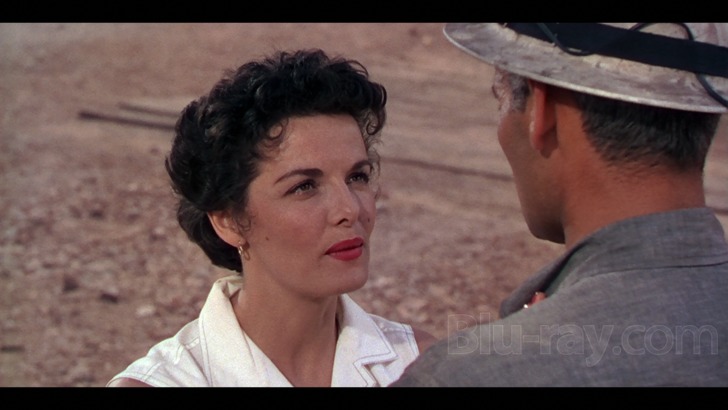
Foxfire is kind of an interesting entry in what might be thought of as the “reassessment” of certain Western tropes during the 1950s, though the film is not “really” a Western, at least in terms of the old “Cowboys versus Indians” angle. Instead, it attempts to wrangle with what a certain chanteuse named Cher once sang about in a tune called “Half Breed”, as focal male character Jonathan Dartland (Jeff Chandler*) grapples with the fact that his father was a Caucasian and his mother an Apache. As Kat Ellinger gets into in her commentary, Chandler, who had made a big splash (and received an Academy Award nomination) as Cochise in Broken Arrow, was frequently cast in “exotic” character roles in those days. Dart, as he’s called throughout the film, “meets cute” with socialite Amanda Lawrence (Jane Russell) in the wilds of Arizona when a car belonging to a resort she’s staying at breaks down and she’s attempting to hoof it back to where she’s staying. Also along for that initial ride that Dart offers her is a hard drinking doctor named Hugh Slater (Dan Duryea), and against a plot ostensibly about a mining operation, the dysfunctional interchanges between these three characters provide most of the emotional content of the film. What's kind of ironic about the whole "reassessment" angle, and something that Ellinger mentions overtly in her commentary, is how the film is almost callously disrespectful to some of its Native American characters (mostly cameos, it should be mentioned) while it purports to evoke empathy and/or sympathy for a main character who is himself half Native American.
While Foxfire never quite attains the hyperbolic histrionics of a typical Douglas Sirk film, there's definitely a Sirkian melodramatic aspect to many of the plot proceedings. Amanda and Dart marry quickly, without Amanda fully knowing about or at least appreciating Dart's inner psychological turmoil due to his "half breed" status. Amanda's mother (Frieda Inescort) is only too aware of Dart's "biracial" background and is none too happy about it, though. While the "half breed" element is at least a subtext, Dart is seemingly more concerned with making a mine he's involved with from an engineering standpoint hit pay dirt, or pay gold, to be precise, leaving Amanda to make friends in the isolated Arizona town of Lodestone. Unfortunately, local tongues wag when one of those friends is Hugh, especially since Hugh is obviously smitten with the beautiful woman. There's a "supporting romance" between Hugh and a pretty nurse named Maria (Mara Corday), even if the main focus is almost always on Amanda and Dart.
If the Apache aspect gives Foxfire its putative "local flavor", in other ways the film plays out in a rather rote manner, especially with regard to the mining subplot, which could have been lifted from either of two 1940 films about oil wells, Boom Town and Flowing Gold. In fact there are several elements at play in Foxfire that are pretty similar to Flowing Gold in particular, including depictions of the "village" life that arises around a well (and/or mine), and one scene in particular where Dart and Amanda share a romantic clinch on the back porch of their little bungalow that is amazingly like a scene between John Garfield and Frances Farmer in the earlier film. Director Joseph Pevney makes the most of his widescreen framings, working with noted cinematographer William H. Daniels to provide nice vistas of the well done location work. Pevney and Daniels also aren't shy about framing Jane Russell in a variety of appealing ways, often accentuating her more than famous figure.
*Note: There's a third piece of trivia that's at least tangentially related to Foxfire, and which may be amusing to Baby Boomers in particular. The iconic character of Race Bannon from the old Jonny Quest animated series from the mid-sixties was reportedly modeled on Jeff Chandler.
Foxfire Blu-ray Movie, Video Quality 
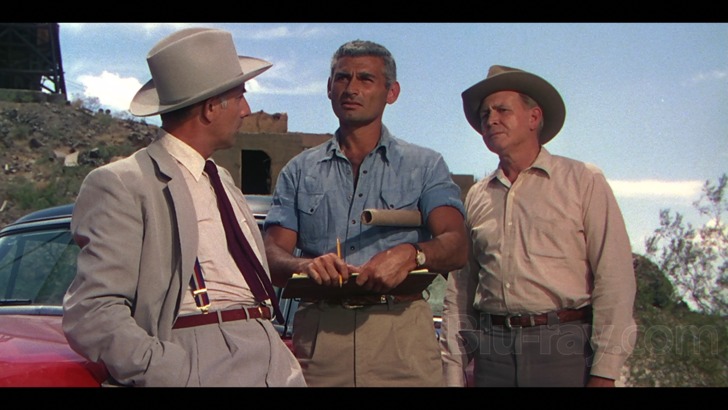
Foxfire is presented on Blu-ray courtesy of Kino Lorber's Studio Classics imprint with an AVC encoded 1080p transfer in 2.00:1. Ellinger mentions the "restoration" done by Kino Lorber, but there's no provenance of whatever source element was utilized offered anywhere on the package. It has to be understood that this late in 3 strip Technicolor things often didn't have the intense saturations that were so evident in earlier uses of the technology, but even so, the palette here is just a bit on the wan side at times, and to my eyes anyway tended to skew a bit toward brown, something that makes some of the legendary Technicolor reds a bit rust or orange looking. There are also slight variations in both densities and especially color temperature. A few isolated moments actually have a warmer palette and more consistent saturation but can look slightly fuzzy (see screenshot 19). There are occasional slight registration problems and also a few isolated specks that pop up from time to time (you can see an example of one bluish- purplish one to the left of the guy holding the dog in screenshot 17). Grain is evident throughout the presentation, for those who worry about a Universal catalog title, and in fact it can tend to clump a bit unnaturally on occasion, though overall I found grain resolution to look nicely organic.
Foxfire Blu-ray Movie, Audio Quality 
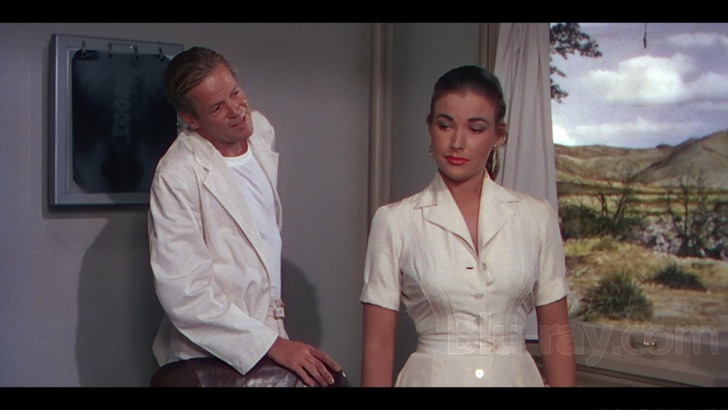
Foxfire features a DTS-HD Master Audio 2.0 mono mix which capably recreates the film's sonics. The track may not be incredibly full bodied, but it supports dialogue perfectly well, and also offers Frank Skinner's score devoid of any distortion. Sound effects also resonate clearly enough and there are no issues with dropouts.
Foxfire Blu-ray Movie, Special Features and Extras 
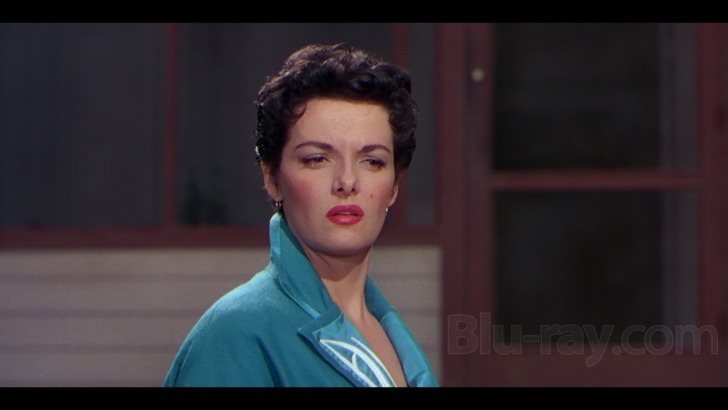
- Audio Commentary by Kat Ellinger
- Trailer (480i; 2:16)
Foxfire Blu-ray Movie, Overall Score and Recommendation 
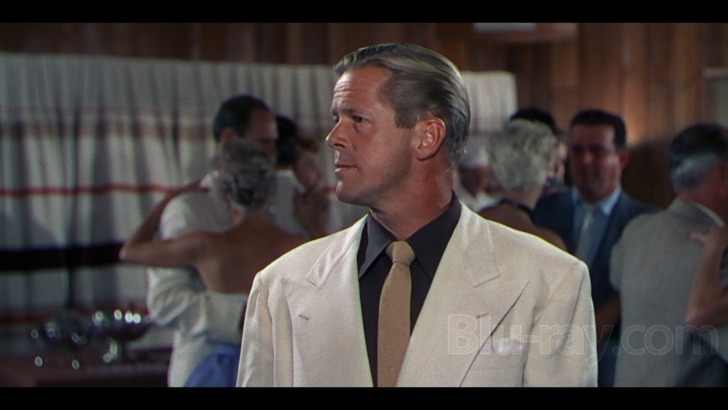
In my guise as a musician I conducted a production of the Mel Brooks musical version of The Producers several years ago where our Max Bialystock was a fantastically funny Portland actor named Jay Pevney, the son of Joseph Pevney and Mitzi Green (for those who don't recognize Green's name, she was a huge Broadway star and had the distinction of debuting two of the most iconic Rodgers and Hart songs of all time, "My Funny Valentine" and "The Lady is a Tramp"). As those of you who have seen any stage version of The Producers musical may have seen, typically Bialystock's office is covered with posters and other memorabilia supposedly from his "illustrious" career, but our set decorator kind of sweetly added a bunch of press materials from both Joseph Pevney's and Mitzi Green's careers to the set of our version. I frankly can't recall if anything from Foxfire was included (there were Tribbles on a shelf, that I can tell you), but for those wanting to acquaint themselves with Joseph Pevney's work, this is an interesting enterprise from a number of standpoints, not the least of which is its place in American cinema history as the last film shot in three strip Technicolor. Technical merits are generally solid, and Foxfire comes Recommended.
Similar titles
Similar titles you might also like

Duel in the Sun
Roadshow Edition
1946

Dodsworth
Warner Archive Collection
1936

The Rainmaker
1956

Westward the Women
Warner Archive Collection
1951

Sayonara
Limited Edition to 3000
1957

A Man Alone
1955

Blood on the Moon
Warner Archive Collection
1948

The Ballad of Cable Hogue
Warner Archive Collection
1970

Bad Day at Black Rock
Warner Archive Collection
1955

Witness 4K
Standard Edition
1985

Pursued
Special Edition
1947

Daisy Kenyon
1947

Days of Wine and Roses
Warner Archive Collection
1962

Man's Castle
1933

Two for the Seesaw
1962

Separate Tables
1958

The Bad and the Beautiful
Warner Archive Collection
1952

Marty
4K Restoration
1955

Highway Dragnet
1954

Next Time We Love
1936
